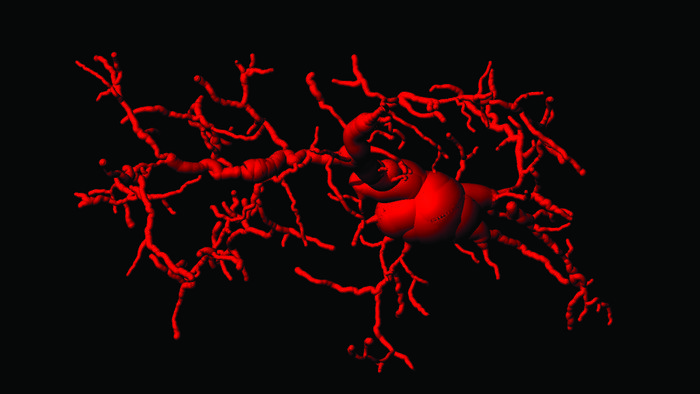Low-grade inflammation contributes to age-related decline and impairment, but the precise pathways responsible for this inflammation and their impact on natural aging have until now remained elusive.
A study headed by researchers at the Swiss Federal Institute of Technology Lausanne (EPFL) has now shown that a molecular signaling pathway known as cGAS/STING plays a critical role in driving chronic inflammation and functional decline during aging. Andrea Ablasser, PhD, and colleagues found that blocking the STING protein suppressed inflammatory responses in human senescent cells and tissues, and reduced aging-related inflammation in multiple peripheral organs and in the brain in mice, leading to an improvement in tissue function. The researchers reported on their studies in Nature, in a paper titled “cGAS–STING drives ageing-related inflammation and neurodegeneration,” in which they suggest that blocking cGAS-STING signaling could represent a potential strategy for holding back age-related neurodegenerative processes.
As we age our organs undergo various changes that reduce their fitness and can impact our overall health, making us more susceptible to diseases. While changes to different body mechanisms can independently contribute to the aging process, many “converge on producing an aberrant inflammatory state that drives age-related decline,” the team noted. “Indeed, attenuation of age-related inflammation has emerged as a common mechanism by which (pharmacological) interventions into aging exert their beneficial effects.”
Previous work by Ablasser and her colleagues linked cGAS/STING to a number of biological processes, including cellular senescence, a hallmark of aging. “However, whether the cGAS–STING pathway directly contributes to cellular senescence in human tissues or age-related inflammation and dysfunction in vivo remains unclear,” they noted.
cGAS/STING is a molecular signaling pathway that detects the presence of DNA in cells. It involves two proteins, cyclic GMP–AMP synthase (cGAS) and Stimulator of Interferon Genes (STING). When activated, cGAS/STING triggers an immune response to defend against viral and bacterial infections. Given the findings of their previous work, the team investigated whether this pathway might underlie maladapted immune responses during aging.
The study also found that activating the STING protein triggers specific patterns of gene activity in microglia, immune cells that represent a first line of defense in the brain. These gene-activation patterns matched those arising in microglia in distinct neurodegenerative conditions, such as Alzheimer’s disease and aging. Studies in senescent cells also showed that using either a small molecule STING inhibitor (H-151) or STING-targeting RNA interference suppressed pro-inflammatory genes and signals, including type I interferon (IFN)-stimulated genes (ISGs), without affecting non-inflammatory features of senescent cells.
Mitochondrial DNA (mtDNA) is a central activator of cGAS–STING signaling, and disrupted mitochondrial homeostasis is a hallmark of aging and neurodegenerative disease, the investigators further noted. Additional analyses in microglia then supported a role for mtDNA in directing inflammatory responses in aged microglia. “In search for a mechanism that would engage the cGAS-STING pathway in aging, we considered aberrant mitochondrial DNA species,” says Ablasser. “Mitochondria, the organelles that are responsible for energy production are well-known for disturbed functioning in aging and disease. Indeed, in microglia from old, but not young mice, DNA from mitochondria accumulated in the cell cytoplasm, suggesting a possible mechanism by which the cGAS-STING pathway contributes to inflammation in the aging brain.” The authors further noted, “Our mechanistic characterization of activated microglia shows that mtDNA accumulates in the cytoplasm to stimulate aged cells, providing a functional link between two central features of aging, namely mitochondrial dysfunction and inflammation.”
The researchers in addition studied the effects of blocking the STING protein in aged mice. As expected by its central role in driving inflammation, inhibiting STING alleviated markers of inflammation both in the periphery and in the brain. “Notably, various aging-related immune signature genes were significantly attenuated as a result of STING inhibition,” they stated. And importantly, animals receiving STING inhibitors displayed significant enhancements in spatial and associative memory, as well as improved muscle strength and physical endurance.
“Consistently, STING inhibition by H-151, a brain permeable compound, reduced the levels of immune-related signature genes in the brains of aged mice,” the scientists pointed out. “Together, these results establish STING as an important driver of aging-associated inflammation, both in the periphery and the CNS, promoting frailty and cognitive decline.”
The study advances our understanding of aging-related inflammation and also offers potential strategies for slowing cognitive deterioration in age-associated neurodegenerative conditions. The precise elucidation of the neuroimmune crosstalk governing microglial-dependent neurotoxicity also holds promise for the future study of neurodegenerative diseases. The team concluded, “Together with previous studies in models of Alzheimer’s disease, Parkinson’s disease, amyotrophic lateral sclerosis and frontotemporal dementia, and Nieman–Pick’s disease, our study reveals notable convergence on cGAS–STING signaling in chronic neurodegenerative conditions … Our findings establish the cGAS–STING pathway as a driver of aging-related inflammation in peripheral organs and the brain, and reveal blockade of cGAS–STING signaling as a potential strategy to halt neurodegenerative processes during old age.”
In an associated News & Views, Bart J.L. Eggen, PhD, at the department of biomedical sciences of cells and systems, University of Groningen, noted, “This study provides key insights into the mechanistic basis of inflammaging in the brain, and a clearer picture of how aging-associated deterioration of organelle and cell fitness leads to neurodegeneration.” Questions do remain, Eggen noted, not least as to whether a hyperactive cGAS protein might be sufficient to induce the characteristics of premature aging in vivo. And reaffirming that the newly published findings in mice will need to be confirmed in humans, who have a far longer lifespan, Eggen concluded, “This molecular pathway does seem to be a key driver of brain aging, but only time will tell whether inhibiting it will open the way to the fountain of youth.”



